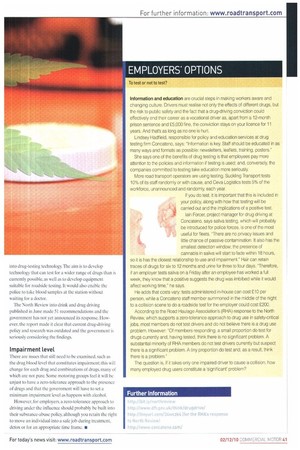The government has not yet acted on June's North Review
Page 40

Page 41

If you've noticed an error in this article please click here to report it so we can fix it.
of drink and drugs driving policy. But driver impairment through drugs is an issue employers must be aware of
Words: Louise Cole
The Royal Society for the Prevention of Accidents says around 18% of people killed in road accidents have traces of illegal drugs in their blood — a six-fold increase since the mid-1980s.lhe latest British Crime Survey suggested approximately 5% of the population had used illicit drugs in the last month. The question for road transport employers is how they can tell whether any of their drivers are among this number.
If a driver causes a collision, fatal or otherwise, while impaired by drink or drugs, the onus would be on the employer to prove they had no indication of the driver's unfitness and had made all relevant licence checks, had broadcast company policy on the issue and taken all reasonable, preventive steps.
However, while prosecution under health and safety or corporate manslaughter laws is certainly a sufficient deterrent to employer apathy, it is by no means the only cost or consequence of an accident: public welfare, insurance premiums, customer trust, reputation and downtime are just a few of the issues. So it makes sense for employers to take alcohol and drug use seriously.
Roadside test Currently, the police subject a driver to a field impairment test for drugs at the roadside.This includes pupil measurement, walking heel to toe and turning, putting your finger on your nose with the eyes closed and estimating the passage of 30 seconds with the eyes closed. If they fail, the driver can be arrested and taken to the police station where a doctor will be summoned for examination and a blood test.
However, the delays in getting a doctor can allow substances to dissipate in the bloodstream and compromise evidence. Therefore, the Home Office. Department for Transport and the Technology Standards Board announced in August a £300,000 fund for further research into drug-testing technology. The aim is to develop technology that can test for a wider range of drugs than is currently possible, as well as to develop equipment suitable for roadside testing. It would also enable the police to take blood samples at the station without waiting for a doctor.
The North Review into drink and drug driving published in June made 51 recommendations and the government has not yet announced its response. However, the report made it clear that current drug-driving policy and research was outdated and the government is seriously considering the findings.
Impairment Level
There are issues that still need to be examined, such as the drug blood level that constitutes impairment; this will change for each drug and combinations of drugs, many of which are not pure. Some motoring groups feel it will be unjust to have a zero-tolerance approach to the presence of drugs and that the government will have to set a minimum impairment level as happens with alcohol.
However, for employers, a zero-tolerance approach to driving under the influence should probably be built into their substance-abuse policy, although you retain the right to move an individual into a safe job during treatment, cletox or for an appropriate time frame.
































































































































